Ancient Greek Structures and British Museum
VerifiedAdded on 2020/11/12
|9
|2357
|402
AI Summary
This assignment delves into the world of ancient Greek architecture and its influence on British museum design. By examining the use of Greek structural elements in building British museums, students can gain a deeper understanding of the similarities between these two seemingly disparate architectural styles. The assignment draws from a range of sources, including books, journals, and online resources, to provide a comprehensive overview of this fascinating topic.
Contribute Materials
Your contribution can guide someone’s learning journey. Share your
documents today.
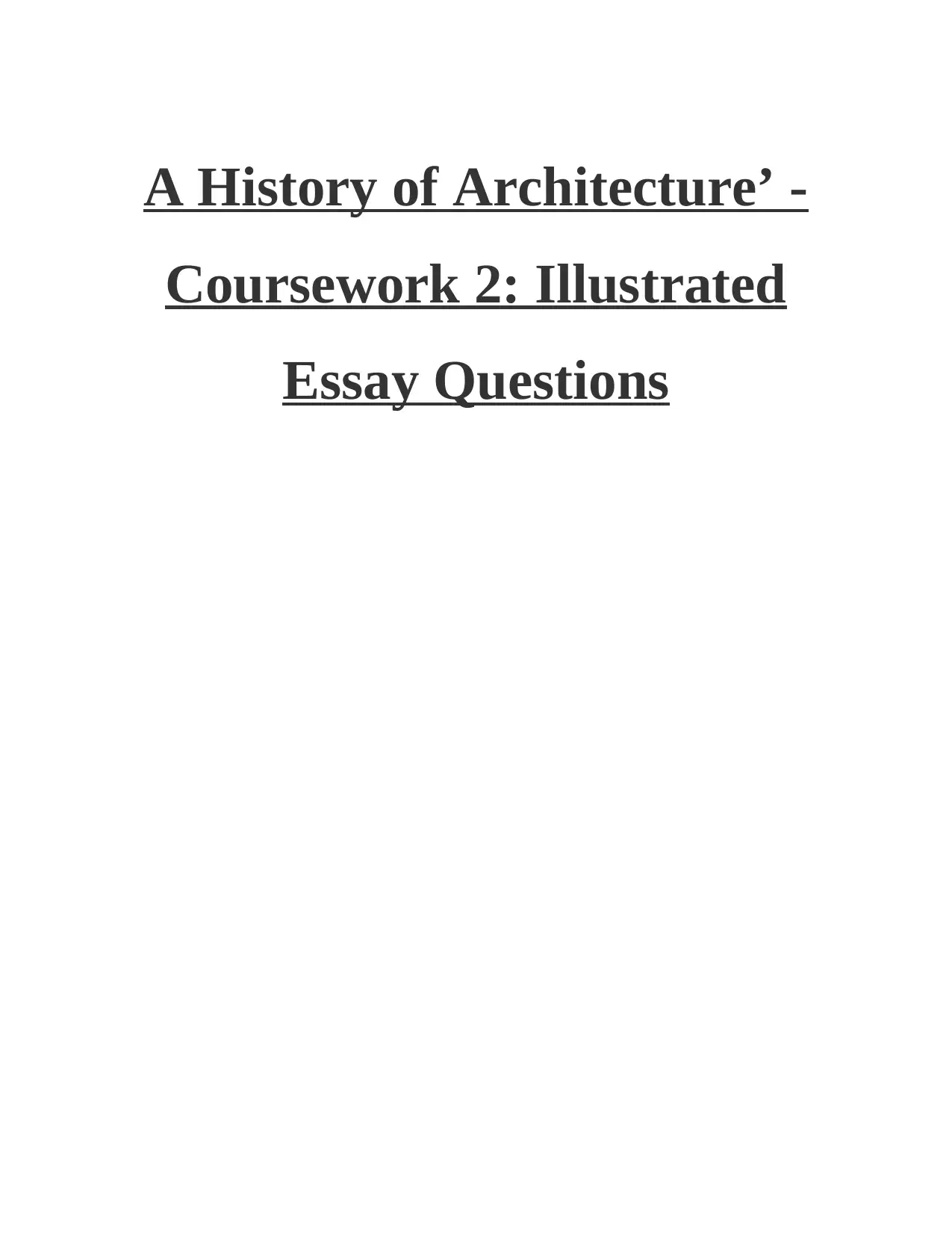
A History of Architecture’ -
Coursework 2: Illustrated
Essay Questions
Coursework 2: Illustrated
Essay Questions
Secure Best Marks with AI Grader
Need help grading? Try our AI Grader for instant feedback on your assignments.
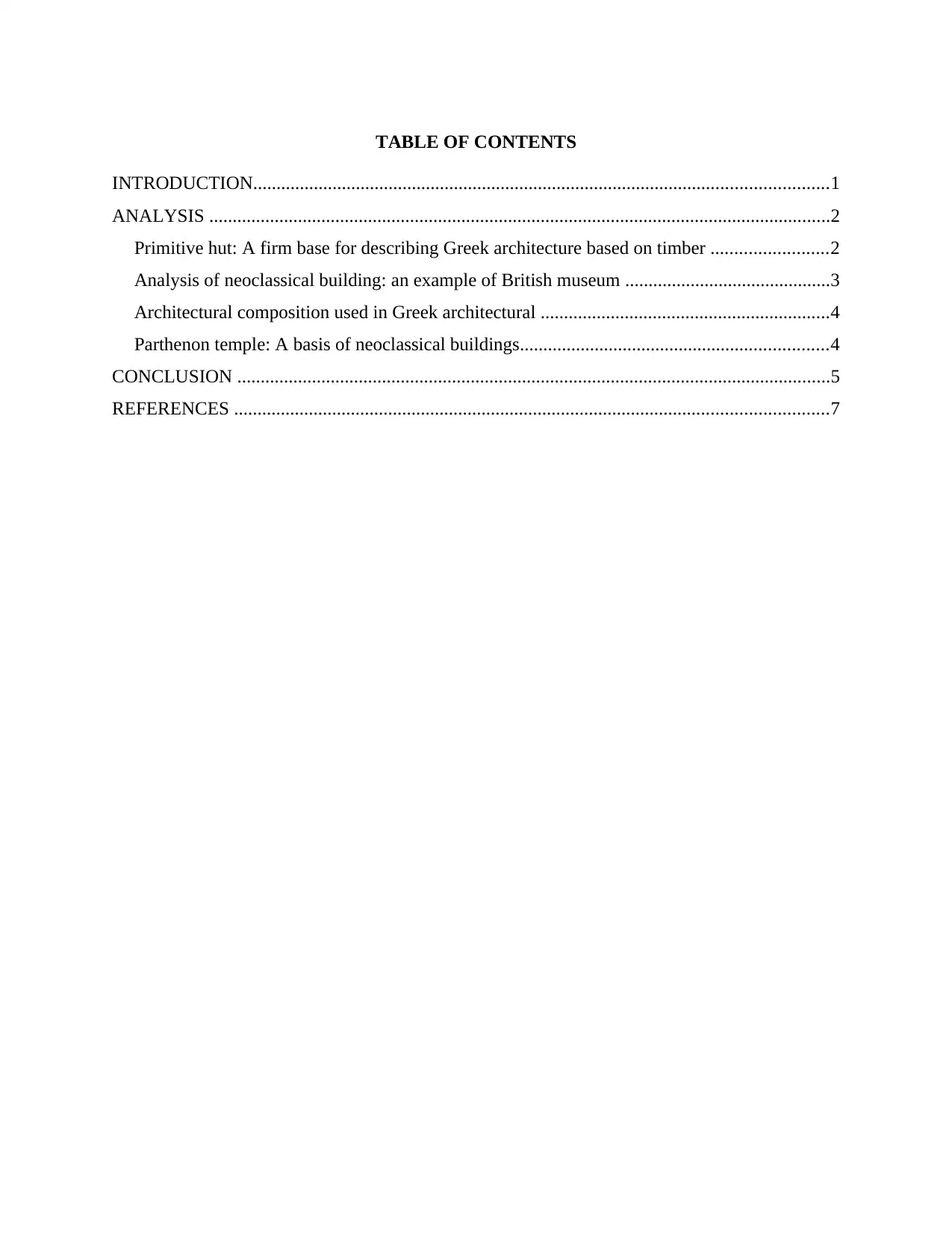
TABLE OF CONTENTS
INTRODUCTION...........................................................................................................................1
ANALYSIS .....................................................................................................................................2
Primitive hut: A firm base for describing Greek architecture based on timber .........................2
Analysis of neoclassical building: an example of British museum ............................................3
Architectural composition used in Greek architectural ..............................................................4
Parthenon temple: A basis of neoclassical buildings..................................................................4
CONCLUSION ...............................................................................................................................5
REFERENCES ...............................................................................................................................7
INTRODUCTION...........................................................................................................................1
ANALYSIS .....................................................................................................................................2
Primitive hut: A firm base for describing Greek architecture based on timber .........................2
Analysis of neoclassical building: an example of British museum ............................................3
Architectural composition used in Greek architectural ..............................................................4
Parthenon temple: A basis of neoclassical buildings..................................................................4
CONCLUSION ...............................................................................................................................5
REFERENCES ...............................................................................................................................7
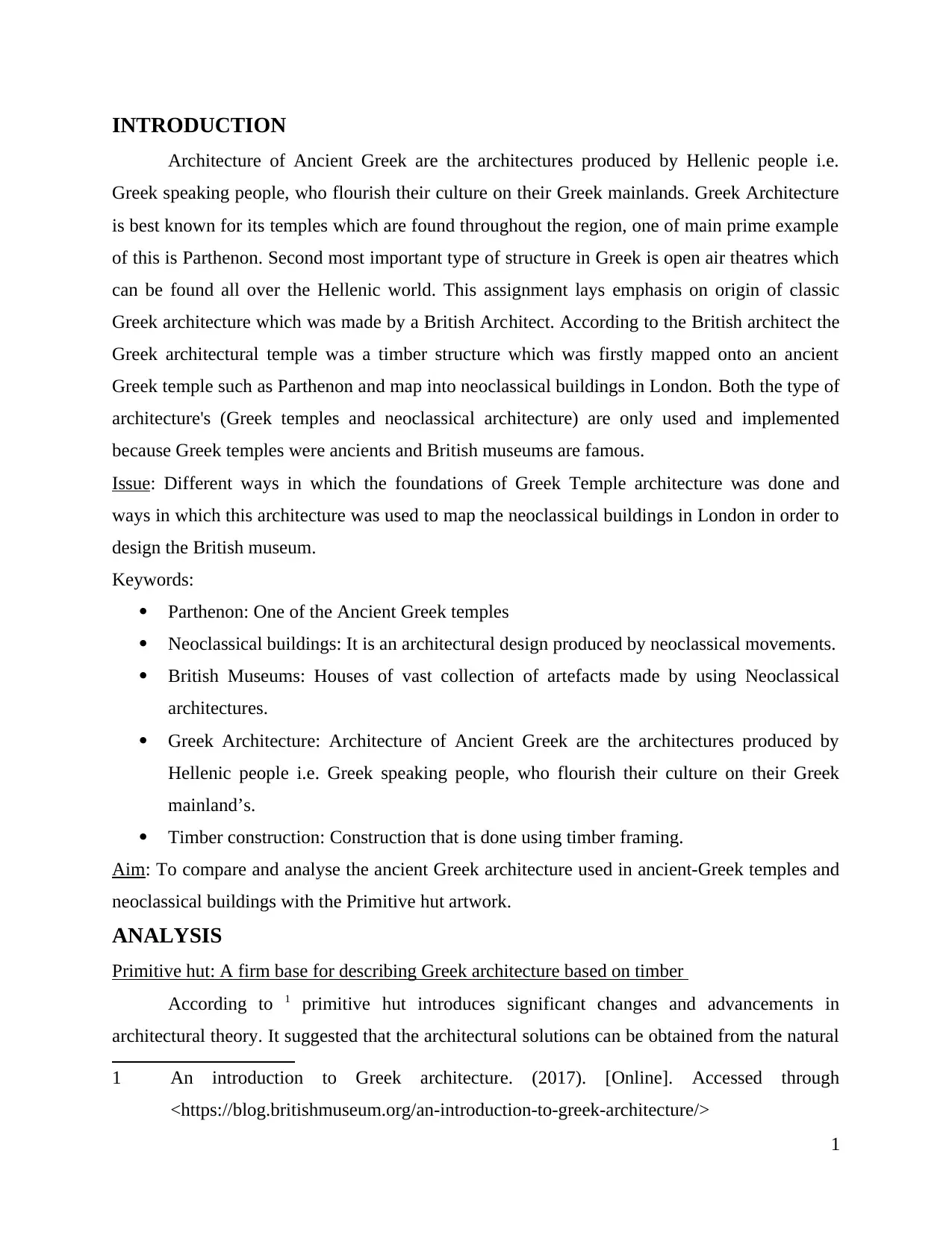
INTRODUCTION
Architecture of Ancient Greek are the architectures produced by Hellenic people i.e.
Greek speaking people, who flourish their culture on their Greek mainlands. Greek Architecture
is best known for its temples which are found throughout the region, one of main prime example
of this is Parthenon. Second most important type of structure in Greek is open air theatres which
can be found all over the Hellenic world. This assignment lays emphasis on origin of classic
Greek architecture which was made by a British Architect. According to the British architect the
Greek architectural temple was a timber structure which was firstly mapped onto an ancient
Greek temple such as Parthenon and map into neoclassical buildings in London. Both the type of
architecture's (Greek temples and neoclassical architecture) are only used and implemented
because Greek temples were ancients and British museums are famous.
Issue: Different ways in which the foundations of Greek Temple architecture was done and
ways in which this architecture was used to map the neoclassical buildings in London in order to
design the British museum.
Keywords:
Parthenon: One of the Ancient Greek temples
Neoclassical buildings: It is an architectural design produced by neoclassical movements.
British Museums: Houses of vast collection of artefacts made by using Neoclassical
architectures.
Greek Architecture: Architecture of Ancient Greek are the architectures produced by
Hellenic people i.e. Greek speaking people, who flourish their culture on their Greek
mainland’s.
Timber construction: Construction that is done using timber framing.
Aim: To compare and analyse the ancient Greek architecture used in ancient-Greek temples and
neoclassical buildings with the Primitive hut artwork.
ANALYSIS
Primitive hut: A firm base for describing Greek architecture based on timber
According to 1 primitive hut introduces significant changes and advancements in
architectural theory. It suggested that the architectural solutions can be obtained from the natural
1 An introduction to Greek architecture. (2017). [Online]. Accessed through
<https://blog.britishmuseum.org/an-introduction-to-greek-architecture/>
1
Architecture of Ancient Greek are the architectures produced by Hellenic people i.e.
Greek speaking people, who flourish their culture on their Greek mainlands. Greek Architecture
is best known for its temples which are found throughout the region, one of main prime example
of this is Parthenon. Second most important type of structure in Greek is open air theatres which
can be found all over the Hellenic world. This assignment lays emphasis on origin of classic
Greek architecture which was made by a British Architect. According to the British architect the
Greek architectural temple was a timber structure which was firstly mapped onto an ancient
Greek temple such as Parthenon and map into neoclassical buildings in London. Both the type of
architecture's (Greek temples and neoclassical architecture) are only used and implemented
because Greek temples were ancients and British museums are famous.
Issue: Different ways in which the foundations of Greek Temple architecture was done and
ways in which this architecture was used to map the neoclassical buildings in London in order to
design the British museum.
Keywords:
Parthenon: One of the Ancient Greek temples
Neoclassical buildings: It is an architectural design produced by neoclassical movements.
British Museums: Houses of vast collection of artefacts made by using Neoclassical
architectures.
Greek Architecture: Architecture of Ancient Greek are the architectures produced by
Hellenic people i.e. Greek speaking people, who flourish their culture on their Greek
mainland’s.
Timber construction: Construction that is done using timber framing.
Aim: To compare and analyse the ancient Greek architecture used in ancient-Greek temples and
neoclassical buildings with the Primitive hut artwork.
ANALYSIS
Primitive hut: A firm base for describing Greek architecture based on timber
According to 1 primitive hut introduces significant changes and advancements in
architectural theory. It suggested that the architectural solutions can be obtained from the natural
1 An introduction to Greek architecture. (2017). [Online]. Accessed through
<https://blog.britishmuseum.org/an-introduction-to-greek-architecture/>
1
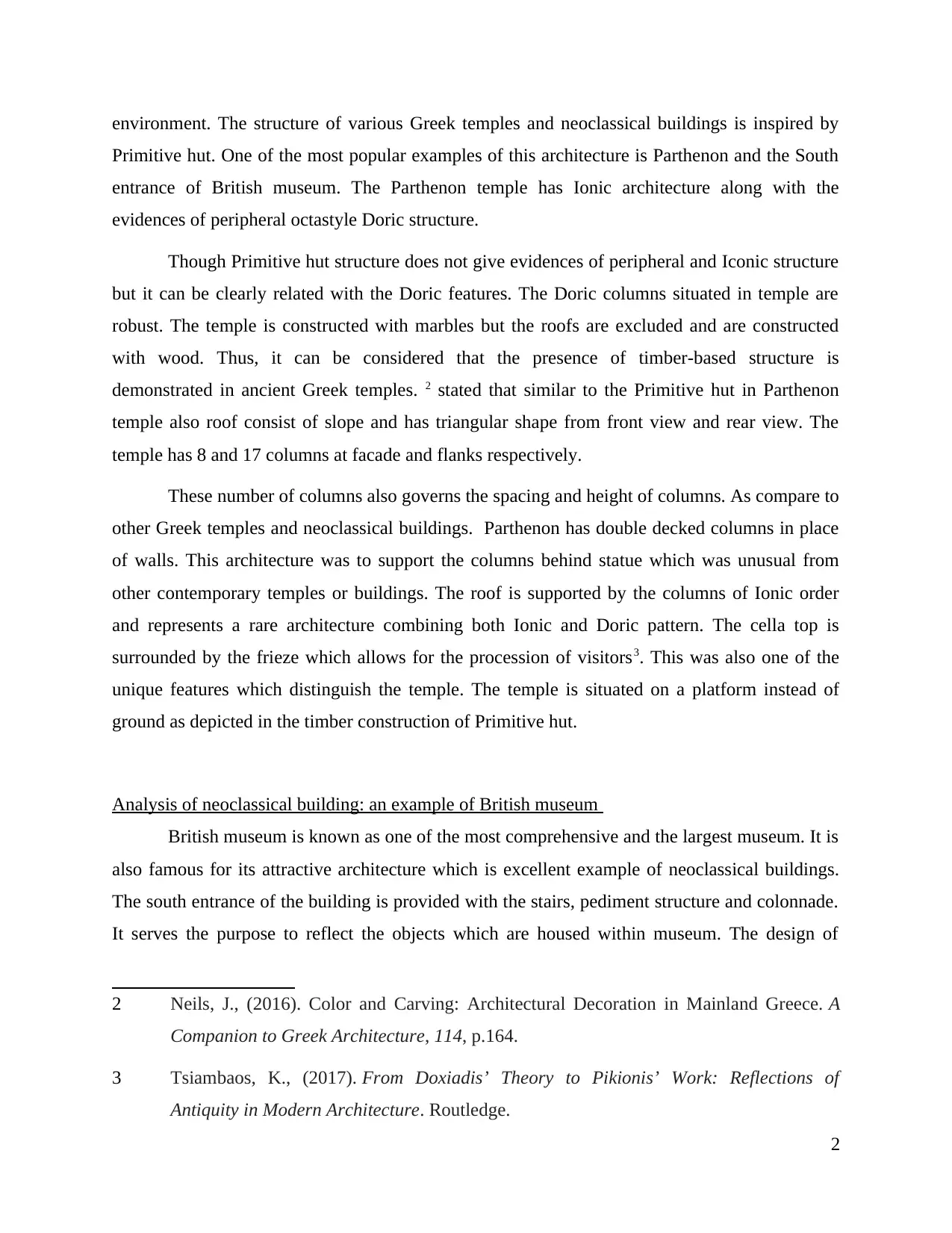
environment. The structure of various Greek temples and neoclassical buildings is inspired by
Primitive hut. One of the most popular examples of this architecture is Parthenon and the South
entrance of British museum. The Parthenon temple has Ionic architecture along with the
evidences of peripheral octastyle Doric structure.
Though Primitive hut structure does not give evidences of peripheral and Iconic structure
but it can be clearly related with the Doric features. The Doric columns situated in temple are
robust. The temple is constructed with marbles but the roofs are excluded and are constructed
with wood. Thus, it can be considered that the presence of timber-based structure is
demonstrated in ancient Greek temples. 2 stated that similar to the Primitive hut in Parthenon
temple also roof consist of slope and has triangular shape from front view and rear view. The
temple has 8 and 17 columns at facade and flanks respectively.
These number of columns also governs the spacing and height of columns. As compare to
other Greek temples and neoclassical buildings. Parthenon has double decked columns in place
of walls. This architecture was to support the columns behind statue which was unusual from
other contemporary temples or buildings. The roof is supported by the columns of Ionic order
and represents a rare architecture combining both Ionic and Doric pattern. The cella top is
surrounded by the frieze which allows for the procession of visitors3. This was also one of the
unique features which distinguish the temple. The temple is situated on a platform instead of
ground as depicted in the timber construction of Primitive hut.
Analysis of neoclassical building: an example of British museum
British museum is known as one of the most comprehensive and the largest museum. It is
also famous for its attractive architecture which is excellent example of neoclassical buildings.
The south entrance of the building is provided with the stairs, pediment structure and colonnade.
It serves the purpose to reflect the objects which are housed within museum. The design of
2 Neils, J., (2016). Color and Carving: Architectural Decoration in Mainland Greece. A
Companion to Greek Architecture, 114, p.164.
3 Tsiambaos, K., (2017). From Doxiadis’ Theory to Pikionis’ Work: Reflections of
Antiquity in Modern Architecture. Routledge.
2
Primitive hut. One of the most popular examples of this architecture is Parthenon and the South
entrance of British museum. The Parthenon temple has Ionic architecture along with the
evidences of peripheral octastyle Doric structure.
Though Primitive hut structure does not give evidences of peripheral and Iconic structure
but it can be clearly related with the Doric features. The Doric columns situated in temple are
robust. The temple is constructed with marbles but the roofs are excluded and are constructed
with wood. Thus, it can be considered that the presence of timber-based structure is
demonstrated in ancient Greek temples. 2 stated that similar to the Primitive hut in Parthenon
temple also roof consist of slope and has triangular shape from front view and rear view. The
temple has 8 and 17 columns at facade and flanks respectively.
These number of columns also governs the spacing and height of columns. As compare to
other Greek temples and neoclassical buildings. Parthenon has double decked columns in place
of walls. This architecture was to support the columns behind statue which was unusual from
other contemporary temples or buildings. The roof is supported by the columns of Ionic order
and represents a rare architecture combining both Ionic and Doric pattern. The cella top is
surrounded by the frieze which allows for the procession of visitors3. This was also one of the
unique features which distinguish the temple. The temple is situated on a platform instead of
ground as depicted in the timber construction of Primitive hut.
Analysis of neoclassical building: an example of British museum
British museum is known as one of the most comprehensive and the largest museum. It is
also famous for its attractive architecture which is excellent example of neoclassical buildings.
The south entrance of the building is provided with the stairs, pediment structure and colonnade.
It serves the purpose to reflect the objects which are housed within museum. The design of
2 Neils, J., (2016). Color and Carving: Architectural Decoration in Mainland Greece. A
Companion to Greek Architecture, 114, p.164.
3 Tsiambaos, K., (2017). From Doxiadis’ Theory to Pikionis’ Work: Reflections of
Antiquity in Modern Architecture. Routledge.
2
Secure Best Marks with AI Grader
Need help grading? Try our AI Grader for instant feedback on your assignments.

museum columns is inspired by the Greek temples. There has been similarity between the
column structure of Parthenon and museum. 4
Along with the columns both the building structures have pediment which gives another
similar architectural feature with Primitive hut. Both sides of the entrance are provided with the
modest exterior. On the pediment of museum sculpture is also provided. The main purpose of the
pediments on building was to enhance the beauty of buildings by using reliefs or sculptures as
well as to depict the purpose of construction or building. Due to this reason this architecture
concept was mainly followed by temples.
However, the designing of Museum was inspired by Greek temples and thus its south
entrance was constructed with trademark of Green temples like pediments and columns. For
providing more support to the roof of building the top column section were given more width. It
also enhances the beauty of the columns 5. Though the section between pediment and column
which is known as frieze is constructed for decoration purpose and is usually provided with the
sculptural details. Parthenon are provided with such frieze structures however the museum does
not have any sculptures on its frieze.
Most of the sculpture of the British museum is taken from the Parthenon. The Elgin
collection and marbles were used in both the structures particularly in sculptures of Parthenon.
The temple was considered as the symbol of cultural pre-eminence and political influence of
Athenians in Greece during fifth century. The British museum was also developed with the
similar architecture and sculpture so that it can represents the great culture and history of Britain.
The most attractive feature of south gate of the museum is its colonnade of forty-four columns
which are based upon the Ionic Greek architecture. The capitals of these columns are very loose
and is similar to the Parthenon temple. The Parthenon is primarily a Doric architecture with few
Ionic elements and sculptural pieces for decoration. Later in 1806 the sculptures of Parthenon
4 Miles, M.M. ed., (2016). A Companion to Greek Architecture (Vol. 114). John Wiley &
Sons.
5 Jones, M.W., (2017). Approaches to Architectural Proportion and the ‘Poor old
Parthenon’. In Proportional Systems in the History of Architecture. A Critical
Reconsideration. Leiden University Press.
3
column structure of Parthenon and museum. 4
Along with the columns both the building structures have pediment which gives another
similar architectural feature with Primitive hut. Both sides of the entrance are provided with the
modest exterior. On the pediment of museum sculpture is also provided. The main purpose of the
pediments on building was to enhance the beauty of buildings by using reliefs or sculptures as
well as to depict the purpose of construction or building. Due to this reason this architecture
concept was mainly followed by temples.
However, the designing of Museum was inspired by Greek temples and thus its south
entrance was constructed with trademark of Green temples like pediments and columns. For
providing more support to the roof of building the top column section were given more width. It
also enhances the beauty of the columns 5. Though the section between pediment and column
which is known as frieze is constructed for decoration purpose and is usually provided with the
sculptural details. Parthenon are provided with such frieze structures however the museum does
not have any sculptures on its frieze.
Most of the sculpture of the British museum is taken from the Parthenon. The Elgin
collection and marbles were used in both the structures particularly in sculptures of Parthenon.
The temple was considered as the symbol of cultural pre-eminence and political influence of
Athenians in Greece during fifth century. The British museum was also developed with the
similar architecture and sculpture so that it can represents the great culture and history of Britain.
The most attractive feature of south gate of the museum is its colonnade of forty-four columns
which are based upon the Ionic Greek architecture. The capitals of these columns are very loose
and is similar to the Parthenon temple. The Parthenon is primarily a Doric architecture with few
Ionic elements and sculptural pieces for decoration. Later in 1806 the sculptures of Parthenon
4 Miles, M.M. ed., (2016). A Companion to Greek Architecture (Vol. 114). John Wiley &
Sons.
5 Jones, M.W., (2017). Approaches to Architectural Proportion and the ‘Poor old
Parthenon’. In Proportional Systems in the History of Architecture. A Critical
Reconsideration. Leiden University Press.
3

temple were taken and housed in British museum. These sculptural elements were called Elgin or
Parthenon marbles which are still enhancing the elegance of British museum.
The museum can be depicted as the limestone house model and has three storeys. Its two
doors are on ground level while the square windows are provided on upper floor. In both
museum and Parthenon cross-braces and mesh coverings are provided which are made up of
timber or metal. The exterior brickwork of the museum helped in rising the building corners.
This architecture was very typical and common in late period.
Architectural composition used in Greek architectural
The Parthenon temple consist of stone slab and capital above columns so that tensile
forces can be relieved in the beam 6. This feature is most commonly used architecture pattern of
Greek temples. Another pattern of Greek architecture is construction of trabeated arrangement of
post and beam which is converted into stone in case of timber construction. For providing the
exact alignment to structure it is also provided with the geometry refinements called entasis. The
cella of Doric temple is kept unusually large so that the oversized statues in Greek temples can
be accommodated.
The white marble of Parthenon has changed significantly over the years however the
basic architectural structure of the temple is still the same. Most of the sculptures of the temple
are not visible now they have lost with time. The baseless columns and square capitals provide
the support to colonnade and entablature. The roof structure of the neoclassical buildings and
ancient Greek temples is characterised by the simple architrave, stone bands, grooved blocks as
well as metopes.
Parthenon temple: A basis of neoclassical buildings
Being a classical example of Doric peripheral Parthenon has rectangular floor plan. A
series of low steps are provided with a colonnade size of 8-17. The crepidoma is provided with
three levels. Normally 6 columns were used in other Greek buildings but in Parthenon 8 colunms
were used along front and rear side. As per the views of 7 the extraordinary refinements are
6 Papadopoulos, K. & Vayas, I., (2019). Restoration and Strengthening Techniques for
Ancient-Greek Monuments.International Journal of Architectural Heritage, 13(1),
pp.33-46.
7 Parthenon. (2012). [Online]. Accessed through <https://www.ancient.eu/parthenon/>
4
Parthenon marbles which are still enhancing the elegance of British museum.
The museum can be depicted as the limestone house model and has three storeys. Its two
doors are on ground level while the square windows are provided on upper floor. In both
museum and Parthenon cross-braces and mesh coverings are provided which are made up of
timber or metal. The exterior brickwork of the museum helped in rising the building corners.
This architecture was very typical and common in late period.
Architectural composition used in Greek architectural
The Parthenon temple consist of stone slab and capital above columns so that tensile
forces can be relieved in the beam 6. This feature is most commonly used architecture pattern of
Greek temples. Another pattern of Greek architecture is construction of trabeated arrangement of
post and beam which is converted into stone in case of timber construction. For providing the
exact alignment to structure it is also provided with the geometry refinements called entasis. The
cella of Doric temple is kept unusually large so that the oversized statues in Greek temples can
be accommodated.
The white marble of Parthenon has changed significantly over the years however the
basic architectural structure of the temple is still the same. Most of the sculptures of the temple
are not visible now they have lost with time. The baseless columns and square capitals provide
the support to colonnade and entablature. The roof structure of the neoclassical buildings and
ancient Greek temples is characterised by the simple architrave, stone bands, grooved blocks as
well as metopes.
Parthenon temple: A basis of neoclassical buildings
Being a classical example of Doric peripheral Parthenon has rectangular floor plan. A
series of low steps are provided with a colonnade size of 8-17. The crepidoma is provided with
three levels. Normally 6 columns were used in other Greek buildings but in Parthenon 8 colunms
were used along front and rear side. As per the views of 7 the extraordinary refinements are
6 Papadopoulos, K. & Vayas, I., (2019). Restoration and Strengthening Techniques for
Ancient-Greek Monuments.International Journal of Architectural Heritage, 13(1),
pp.33-46.
7 Parthenon. (2012). [Online]. Accessed through <https://www.ancient.eu/parthenon/>
4
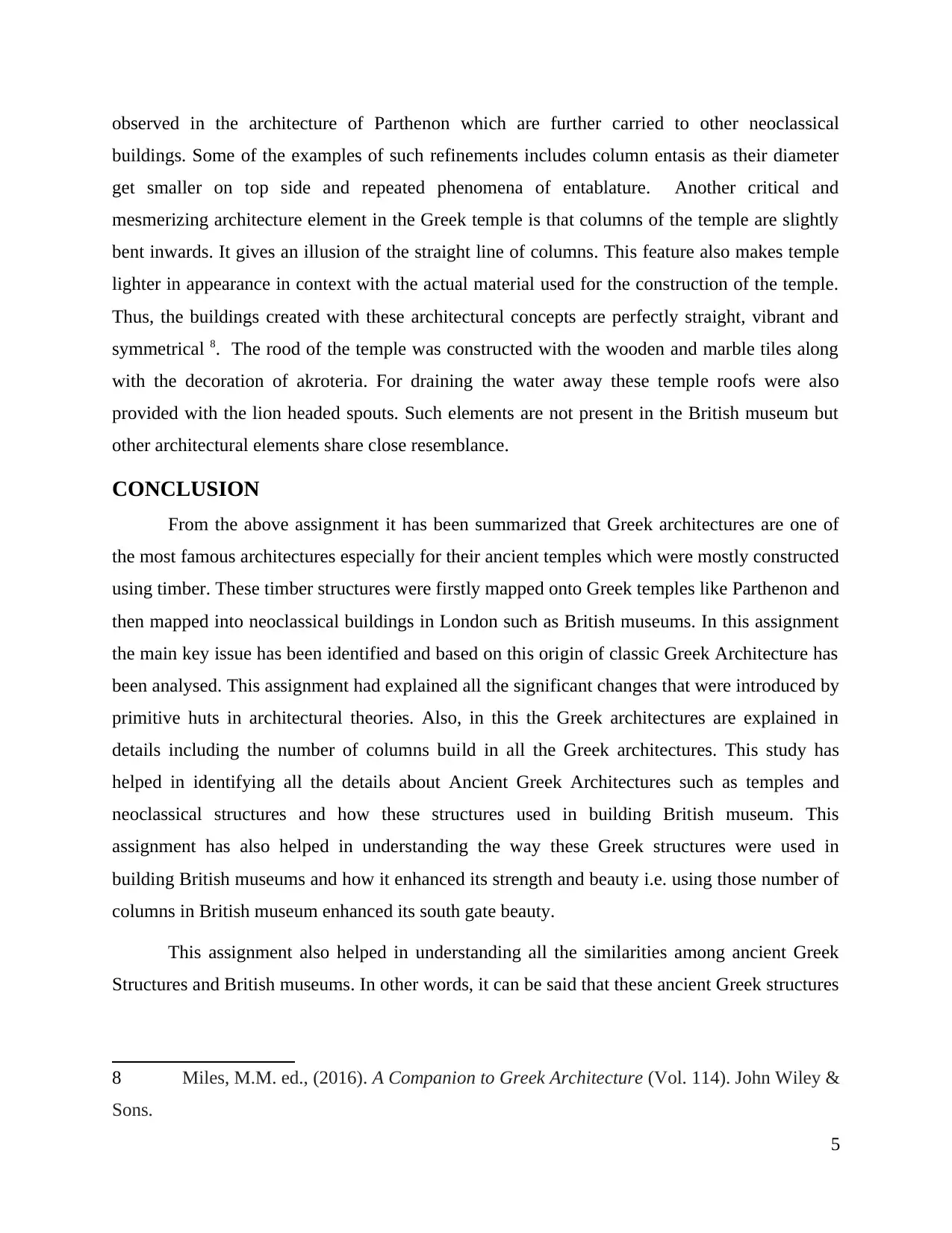
observed in the architecture of Parthenon which are further carried to other neoclassical
buildings. Some of the examples of such refinements includes column entasis as their diameter
get smaller on top side and repeated phenomena of entablature. Another critical and
mesmerizing architecture element in the Greek temple is that columns of the temple are slightly
bent inwards. It gives an illusion of the straight line of columns. This feature also makes temple
lighter in appearance in context with the actual material used for the construction of the temple.
Thus, the buildings created with these architectural concepts are perfectly straight, vibrant and
symmetrical 8. The rood of the temple was constructed with the wooden and marble tiles along
with the decoration of akroteria. For draining the water away these temple roofs were also
provided with the lion headed spouts. Such elements are not present in the British museum but
other architectural elements share close resemblance.
CONCLUSION
From the above assignment it has been summarized that Greek architectures are one of
the most famous architectures especially for their ancient temples which were mostly constructed
using timber. These timber structures were firstly mapped onto Greek temples like Parthenon and
then mapped into neoclassical buildings in London such as British museums. In this assignment
the main key issue has been identified and based on this origin of classic Greek Architecture has
been analysed. This assignment had explained all the significant changes that were introduced by
primitive huts in architectural theories. Also, in this the Greek architectures are explained in
details including the number of columns build in all the Greek architectures. This study has
helped in identifying all the details about Ancient Greek Architectures such as temples and
neoclassical structures and how these structures used in building British museum. This
assignment has also helped in understanding the way these Greek structures were used in
building British museums and how it enhanced its strength and beauty i.e. using those number of
columns in British museum enhanced its south gate beauty.
This assignment also helped in understanding all the similarities among ancient Greek
Structures and British museums. In other words, it can be said that these ancient Greek structures
8 Miles, M.M. ed., (2016). A Companion to Greek Architecture (Vol. 114). John Wiley &
Sons.
5
buildings. Some of the examples of such refinements includes column entasis as their diameter
get smaller on top side and repeated phenomena of entablature. Another critical and
mesmerizing architecture element in the Greek temple is that columns of the temple are slightly
bent inwards. It gives an illusion of the straight line of columns. This feature also makes temple
lighter in appearance in context with the actual material used for the construction of the temple.
Thus, the buildings created with these architectural concepts are perfectly straight, vibrant and
symmetrical 8. The rood of the temple was constructed with the wooden and marble tiles along
with the decoration of akroteria. For draining the water away these temple roofs were also
provided with the lion headed spouts. Such elements are not present in the British museum but
other architectural elements share close resemblance.
CONCLUSION
From the above assignment it has been summarized that Greek architectures are one of
the most famous architectures especially for their ancient temples which were mostly constructed
using timber. These timber structures were firstly mapped onto Greek temples like Parthenon and
then mapped into neoclassical buildings in London such as British museums. In this assignment
the main key issue has been identified and based on this origin of classic Greek Architecture has
been analysed. This assignment had explained all the significant changes that were introduced by
primitive huts in architectural theories. Also, in this the Greek architectures are explained in
details including the number of columns build in all the Greek architectures. This study has
helped in identifying all the details about Ancient Greek Architectures such as temples and
neoclassical structures and how these structures used in building British museum. This
assignment has also helped in understanding the way these Greek structures were used in
building British museums and how it enhanced its strength and beauty i.e. using those number of
columns in British museum enhanced its south gate beauty.
This assignment also helped in understanding all the similarities among ancient Greek
Structures and British museums. In other words, it can be said that these ancient Greek structures
8 Miles, M.M. ed., (2016). A Companion to Greek Architecture (Vol. 114). John Wiley &
Sons.
5
Paraphrase This Document
Need a fresh take? Get an instant paraphrase of this document with our AI Paraphraser

like temple and neoclassical structures were used in building of British museum in a same way as
neoclassical structures in Greek were used and enhanced its beauty and strength in various ways.
6
neoclassical structures in Greek were used and enhanced its beauty and strength in various ways.
6
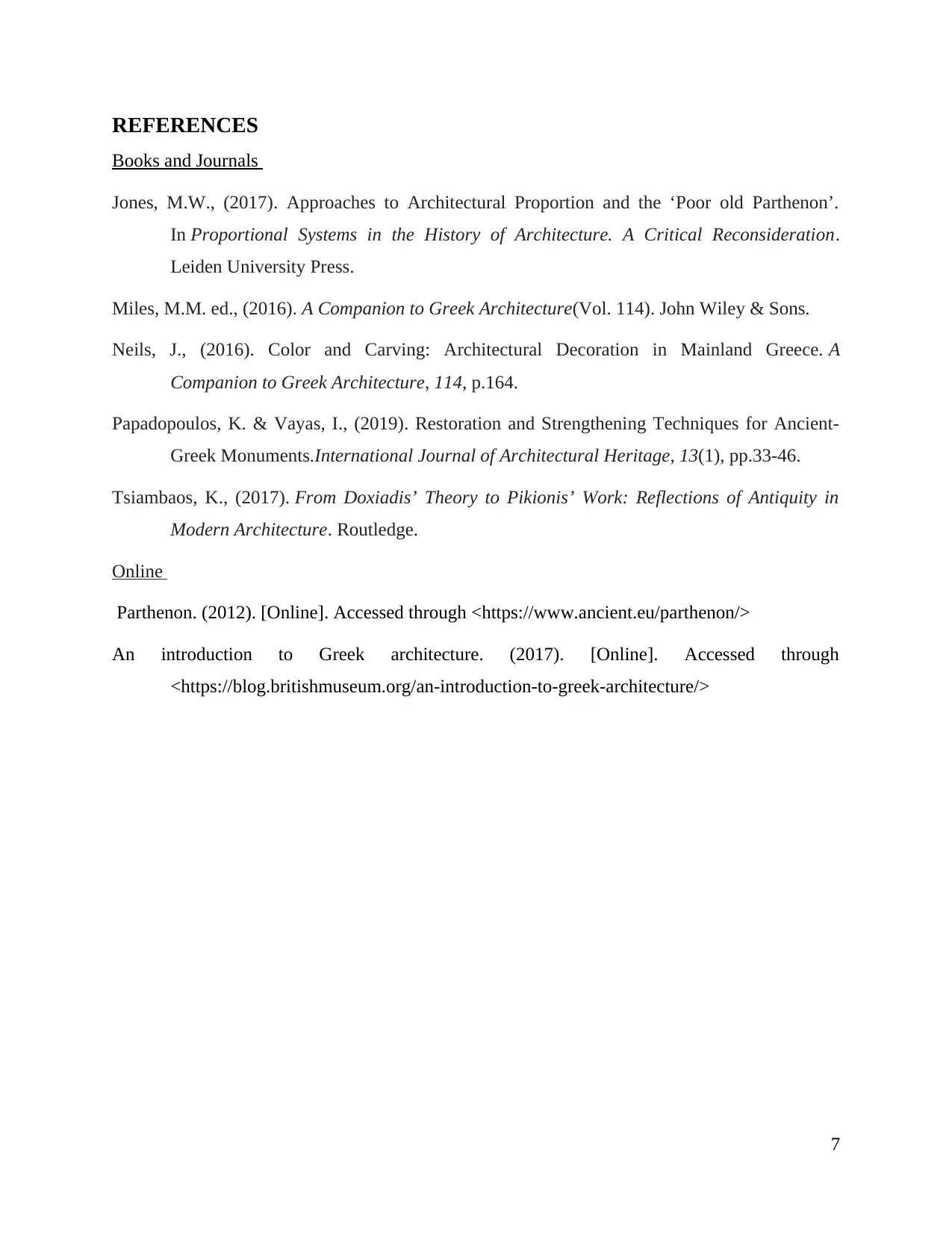
REFERENCES
Books and Journals
Jones, M.W., (2017). Approaches to Architectural Proportion and the ‘Poor old Parthenon’.
In Proportional Systems in the History of Architecture. A Critical Reconsideration.
Leiden University Press.
Miles, M.M. ed., (2016). A Companion to Greek Architecture(Vol. 114). John Wiley & Sons.
Neils, J., (2016). Color and Carving: Architectural Decoration in Mainland Greece. A
Companion to Greek Architecture, 114, p.164.
Papadopoulos, K. & Vayas, I., (2019). Restoration and Strengthening Techniques for Ancient-
Greek Monuments.International Journal of Architectural Heritage, 13(1), pp.33-46.
Tsiambaos, K., (2017). From Doxiadis’ Theory to Pikionis’ Work: Reflections of Antiquity in
Modern Architecture. Routledge.
Online
Parthenon. (2012). [Online]. Accessed through <https://www.ancient.eu/parthenon/>
An introduction to Greek architecture. (2017). [Online]. Accessed through
<https://blog.britishmuseum.org/an-introduction-to-greek-architecture/>
7
Books and Journals
Jones, M.W., (2017). Approaches to Architectural Proportion and the ‘Poor old Parthenon’.
In Proportional Systems in the History of Architecture. A Critical Reconsideration.
Leiden University Press.
Miles, M.M. ed., (2016). A Companion to Greek Architecture(Vol. 114). John Wiley & Sons.
Neils, J., (2016). Color and Carving: Architectural Decoration in Mainland Greece. A
Companion to Greek Architecture, 114, p.164.
Papadopoulos, K. & Vayas, I., (2019). Restoration and Strengthening Techniques for Ancient-
Greek Monuments.International Journal of Architectural Heritage, 13(1), pp.33-46.
Tsiambaos, K., (2017). From Doxiadis’ Theory to Pikionis’ Work: Reflections of Antiquity in
Modern Architecture. Routledge.
Online
Parthenon. (2012). [Online]. Accessed through <https://www.ancient.eu/parthenon/>
An introduction to Greek architecture. (2017). [Online]. Accessed through
<https://blog.britishmuseum.org/an-introduction-to-greek-architecture/>
7
1 out of 9
Related Documents
Your All-in-One AI-Powered Toolkit for Academic Success.
+13062052269
info@desklib.com
Available 24*7 on WhatsApp / Email
![[object Object]](/_next/static/media/star-bottom.7253800d.svg)
Unlock your academic potential
© 2024 | Zucol Services PVT LTD | All rights reserved.
